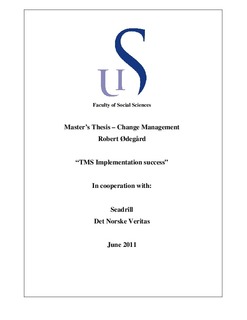| dc.description.abstract | The objective of this study was to look at the implementation of a new management system, and determine to which degree the implementation was successful. The management system is called Total Management System (TMS), and the organisation in which it was implemented is Seadrill. Seadrill is a leading offshore deepwater drilling company, with rigs and operations world wide. Head office is located in Stavanger, Norway. The thesis was also a part of a project within Det Norske Veritas (DNV), were methods for measuring success of implementation processes of management systems should be assessed. The provider of the management system was the Stavanger based company Docmap AS, which have customised and tailored the system to suit Seadrill specifications and needs. Seadrill also had one consultant from DNV hired in to assist during the project phases and the first part of the implementation phase. The implementation has however been carried out by Seadrill themselves. TMS was upon thesis completion still in the implementation phase on some Seadrill owned drilling rigs, but this study was performed on rigs where TMS already had been incorporated and taken into normal use. The main data source for the paper was a quantitative survey performed among users of TMS, located on around 22 Seadrill operated rigs in addition to onshore key personnel. The respondent percentage reached 61% (94 respondents) when closing out the survey. As second hand data, an earlier conducted survey was made available by Seadrill and a few of the questions were repeated to create a comparable set of data. The theoretical perspective on the work focused around Brandsdals VVV-model for determining if a successful organisational change has taken place, as well as bits of theory E and O by Beer and Nohria. Brandsdals VVV model looks at three factors (Knows, Wants, and Works) for organisational changes, whilst theory E and O are describes two types of organisational changes.
The key point of the paper was the close relationship between the actual implementation process of a system and the system itself. A management system cannot work unless implemented properly, and an implementation process will fail if the system being implemented is not properly fit to the organisation. However, the end result is always focused on the management system, whilst the implementation techniques woks as means to achieve the target. The authors’ point of view was therefore that by studying how the users around in the organisation actually perceive and use the implemented system, one can determine if the implementation has been successful. The term ‘successful’ needs to be closely linked to the organisations objectives with the new management system.
The initial results of the survey were indeed quite positive. As expected there were respondents on all parts of the scale, but on most aspects and viewpoints the majority were clearly on the positive side of the scale. This was further demonstrated in the analysis chapters, where the use of correlations, regressions and comparisons continued to support an overall successful implementation. The use of demographic variables like onshore / offshore, rig-type, years of experience and so on, were useful in the work with identifying any groups of users where the implementation might have been less (or more) successful than the others. The analysis showed that TMS has been well received, and are perceived better than previous systems the employees have been using. The available data from the survey conducted in 2009 helped to demonstrate not just that TMS as a system were in general well received in the organisation, but also that TMS was seen as a better tool than what most of the respondents have been working with before. There were no data to name these systems though, as it was not identified where the respondents had experience from prior to Seadrill, if any. So overall, the conclusion was that a successful implementation has taken place.
But of course, as one walks through such a research project one discovers other points of view, other problems that could have been highlighted or potential better ways of answering the research question. No exception for this project. One particular field interesting for more research would have been the interfaces between the implementation process and the management system. They do interact and are very closely linked, but by only studying the end result (users perception of the implemented system), how could one know what has been done wrong if the users were not satisfied? One would than sit with information about a system that does not work to its intentions, whilst the real problem could have been in the implementation phases rather than the system. It would be interesting to work on a clearer distinction between the two factors. And even though believed to give a valid picture of the process, the use of more data sources would both increase the reliability of the work as well as provide even more useful information to Seadrill. Information about the conducted implementation process is very useful information when one continues to run and develop the management system. The survey could also have been developed differently, with an even tighter connection between the questions asked and the developed success criterion for TMS implementation success. There were also some technical aspects with the survey that could have been different, for example the use of a ‘Not relevant’ option on selected questions. This could have increased the reliability of the survey data. | no_NO |
